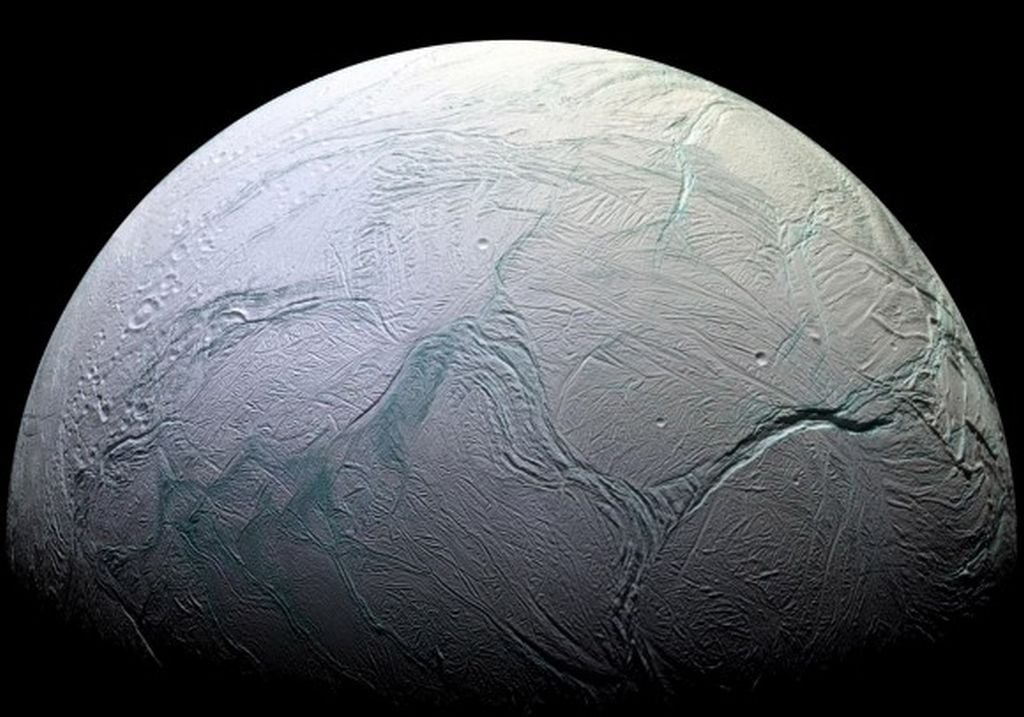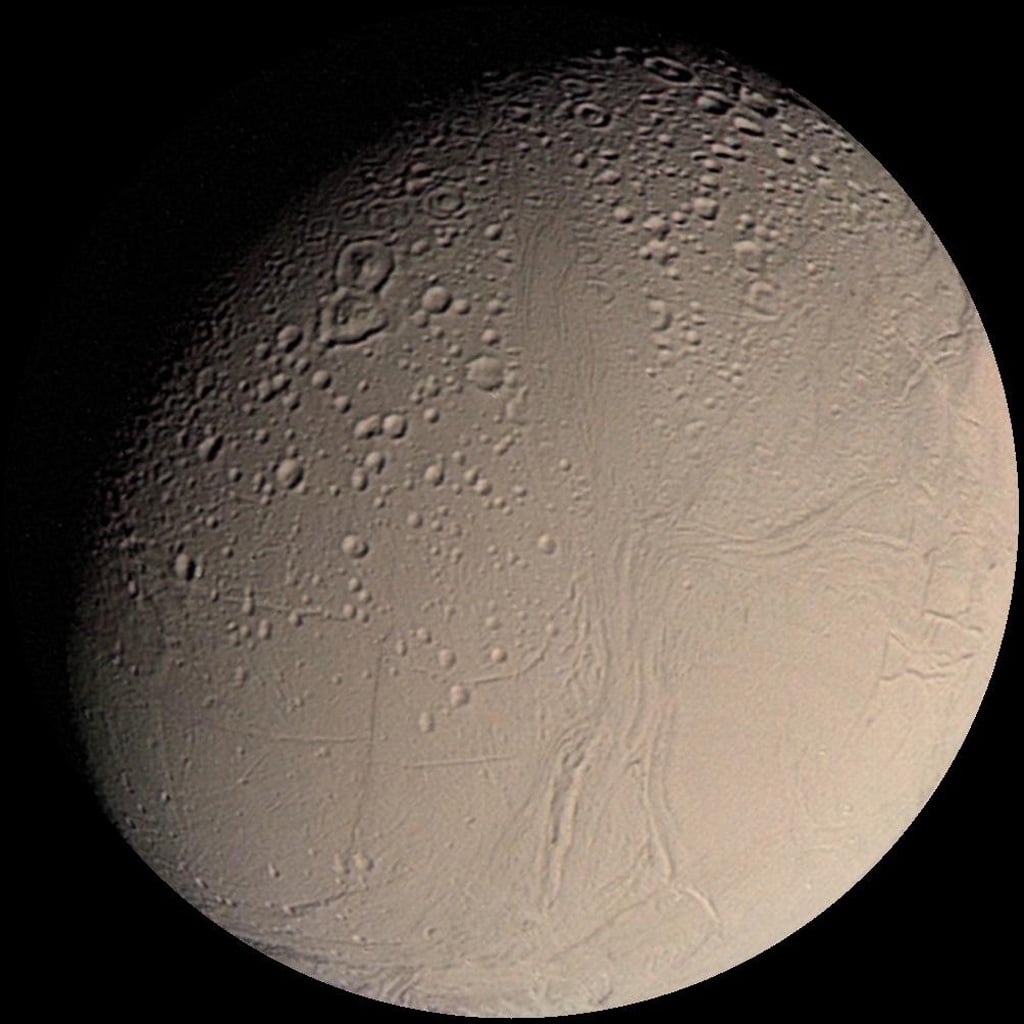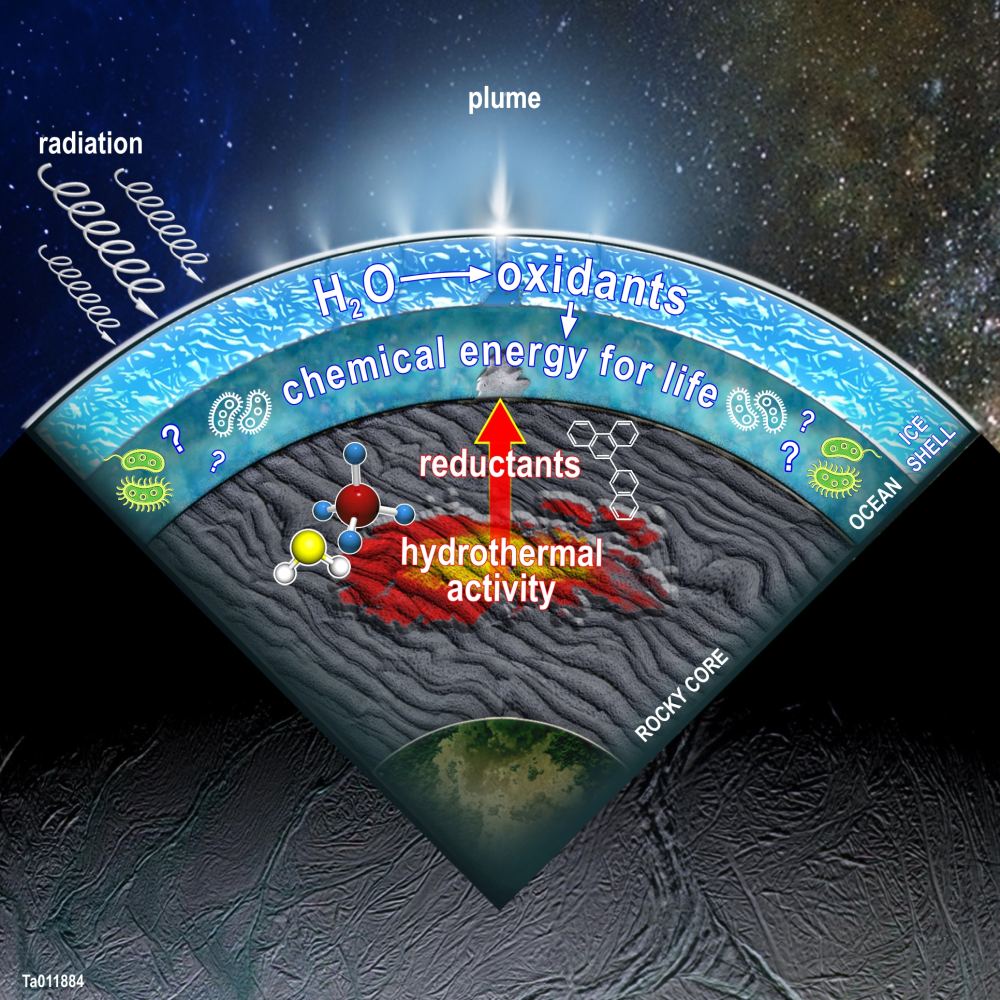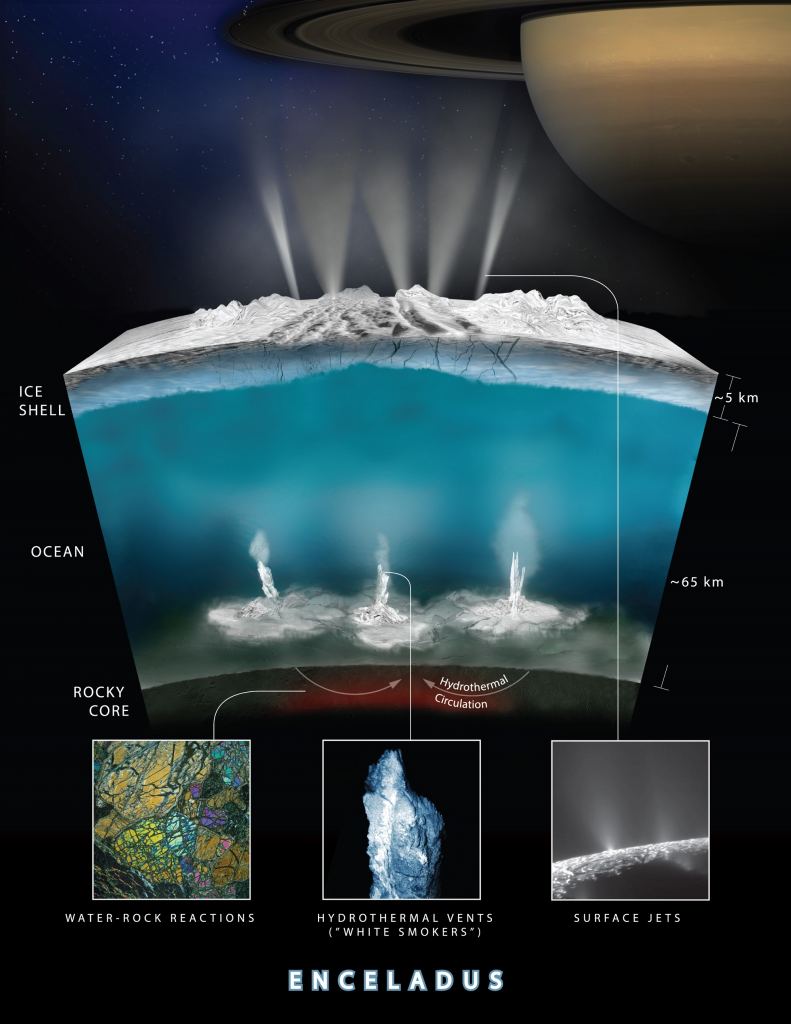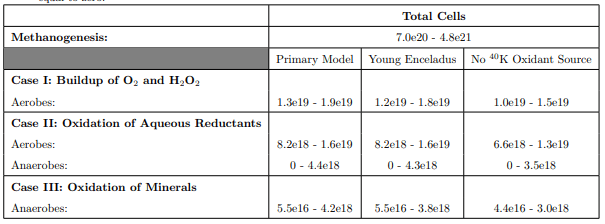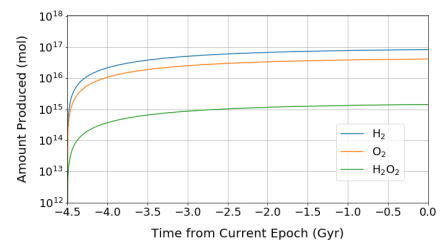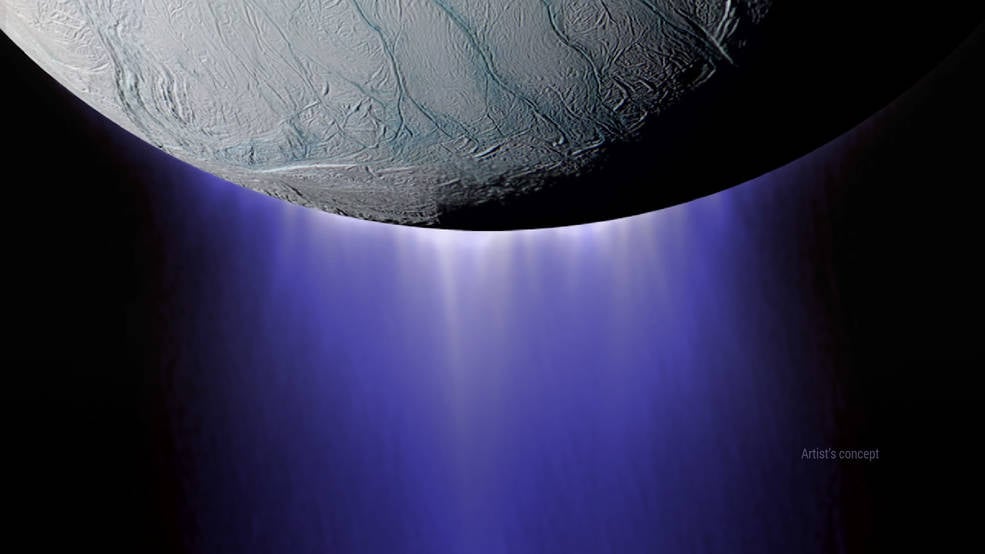When NASA's Voyager spacecraft visited Saturn's moon Enceladus, they found a body with young, reflective, icy surface features. Some parts of the surface were older and marked with craters, but the rest had clearly been resurfaced. It was clear evidence that Enceladus was geologically active. The moon is also close to Saturn's E-ring, and scientists think Enceladus might be the source of the material in that ring, further indicating geological activity.
Since then, we've learned a lot more about the frigid moon. It almost certainly has a warm and salty subsurface ocean below its icy exterior, making it a prime target in the search for life. The Cassini spacecraft detected molecular hydrogen—a potential food source for microbes—in plumes coming from Enceladus' subsurface ocean, and that energized the conversation around the moon's potential to host life.
Now a new paper uses modelling to understand Enceladus' chemistry better. The team of researchers behind it says that the subsurface ocean may contain a variety of chemicals that could support a diverse community of microbes.
As far as the search for life elsewhere in the Solar System goes, Enceladus checks many boxes. Saturn's sixth-largest moon is about 500 km (310 mi) in diameter and seems to have a global ocean buried under a sheet of ice. And that ocean is likely warm and salty and contains some interesting chemicals. According to the new research, there are several pathways among these chemicals that could support life.
The title of the paper is " Oxidation processes diversify the metabolic menu on Enceladus. " The lead author is Christine Ray, a Ph.D. student at the Department of Physics and Astronomy, University of Texas, San Antonio. Ray is also with the Space Science and Engineering Division at Southwest Research Institute (SwRI.) The paper is published in the journal Science Direct.
This work was spurred on by Cassini's discovery of molecular hydrogen in plumes of vapor coming from Enceladus.
"The detection of molecular hydrogen (H2) in the plume indicated that there is free energy available in the ocean of Enceladus," said lead author Ray in a press release. "On Earth, aerobic, or oxygen-breathing, creatures consume energy in organic matter such as glucose and oxygen to create carbon dioxide and water. Anaerobic microbes can metabolize hydrogen to create methane. All life can be distilled to similar chemical reactions associated with a disequilibrium between oxidant and reductant compounds."
The disequilibrium that Ray references creates an energy gradient critical to life. The energy gradient allows energy exchange between an organism and its environment. Processes around these gradients are critical to many aspects of biology, like photosynthesis and respiration. If a system is in equilibrium, there's no energy gradient, creating a barrier to life.
When molecular hydrogen was discovered in the plumes coming from Enceladus, it drew a parallel with deep ocean hydrothermal vents here on Earth. At those vents, hydrogen provides an energy source for an entire ecosystem. People immediately began to wonder if the same might be true for Enceladus.
But this study takes it further. The authors wanted to know if there could be other energy pathways in Enceladus' ocean that were conducive to life.
"We wondered if other types of metabolic pathways could also provide sources of energy in Enceladus' ocean," Ray said. "Because that would require a different set of oxidants that we have not yet detected in the plume of Enceladus, we performed chemical modeling to determine if the conditions in the ocean and the rocky core could support these chemical processes."
When it comes to Enceladus and life, energy availability is key. The authors write in their paper that "Compounds that could be used in metabolic reactions must be present in disequilibrium concentrations, such that biology can extract energy from the environment to drive the system toward equilibrium."
Cassini showed us that thanks to molecular hydrogen, there's at least one pathway for life. The necessary chemicals are present for methanogenesis to take place. That's when molecular hydrogen oxidizes with carbon dioxide to produce methane. This pathway is common on Earth, including in the human gut, where archaea use methanogenesis.
Since there's no spacecraft near Enceladus and no way to gather the type of data needed, the team turned to models. They wondered if oxidants other than carbon dioxide might be present at Enceladus, possibly below Cassini's detection threshold, that might provide another pathway for life.
What this study is really about is the relationship between energy and biology. To explore that relationship on Enceladus, the authors zeroed in on two key concepts: chemical affinity and the flux of energy.
Chemical affinity is the capability of dissimilar chemicals to form compounds, and according to the authors, it's also "... the amount of free energy available from a metabolic reaction." The flux of energy "...determines how much biomass can be supported in steady-state," according to the authors. Much of this comes down to oxidants. In essence, oxidant production determines how much energy is available for life.
The authors wanted to model oxidant production on Enceladus for two reasons: "to 1) constrain the oxidant budget or the concentrations and fluxes of metabolically significant oxidants in the ocean, and 2) determine whether these additional metabolic pathways could provide sufficient energy for life."
To explore all that, they modelled three different cases, as shown in the figure below.
So what did they find?
"This new paper is another step in understanding how a small moon can sustain life in ways that completely exceed our expectations!"Hunter Waite, Co-Author, SwRI Program Director.
They found that, according to their models, there could be enough oxidant production to create other pathways for life. Surface ice could be broken down by energy and release oxidants. This can happen in a couple of ways.
"We have shown that the production of radiolytic oxidants on Enceladus could lead to redox disequilibria in the ocean, which could provide energy to support putative life. Radiolysis of surface ice, coupled with transport of ice to the ocean in the geologically active tiger stripe region, can deliver up to 9.4 × 1015 moles of O2 and 3.3 × 1016 moles of H2O2," they write in their study.
They also found that the decay of a radioactive isotope of potassium (K) could produce oxidants.
"Electrons and gamma rays released as a result of the decay of 40K atoms in the ocean can produce another 4.2 × 1016 moles of O2 and 1.4×1015 moles of H2O2 directly in the ocean."
"We compared our free energy estimates to ecosystems on Earth and determined that, overall, our values for both aerobic and anaerobic metabolisms meet or exceed minimum requirements," Ray said in the press release. "These results indicate that oxidant production and oxidation chemistry could contribute to supporting possible life and a metabolically diverse microbial community on Enceladus."
That in itself is exciting. But there's more.
"Now that we've identified potential food sources for microbes, the next question to ask is 'what is the nature of the complex organics that are coming out of the ocean?'" said SwRI Program Director Dr. Hunter Waite, a coauthor of the new paper. "This new paper is another step in understanding how a small moon can sustain life in ways that completely exceed our expectations!"
"We must be cautious, but I find it exhilarating to ponder whether there might be strange forms of life that take advantage of these sources of energy that appear to be fundamental to the workings of Enceladus."Dr. Christopher Glein, Co-Author, SwRI Senior Research Scientist
Like a lot of modelling and research on other worlds, these results are both tantalizing and a little frustrating. We have to wait for another mission to Enceladus to confirm or exclude. We need another spacecraft, hopefully with finer instruments, to travel through Enceladus' plumes and take more measurements.
"A future spacecraft could fly through the plume of Enceladus to test this paper's predictions on the abundances of oxidized compounds in the ocean," said SwRI Senior Research Scientist Dr. Christopher Glein, another coauthor. "We must be cautious, but I find it exhilarating to ponder whether there might be strange forms of life that take advantage of these sources of energy that appear to be fundamental to the workings of Enceladus."
A mission to Enceladus is in the concept stage right now. NASA's Enceladus Life Finder is a proposal to send a solar-powered orbiter to Enceladus. The Life Finder would orbit Saturn, but would repeatedly fly through Enceladus' vapour plumes taking measurements. It was proposed in 2017 but not selected, but the idea is still alive.
For now, the last word goes to the authors. In their conclusion, they write: "We have shown that, in addition to methanogenesis, aerobic and/or anaerobic reactions in each of our three cases can meet the minimum free energy requirement for terrestrial life, ?Gmin, and provide maintenance energy to support cellular life within Enceladus."
"Radiolytic oxidant production and redox chemistry in Enceladus' ocean and seafloor are therefore capable of supporting metabolic processes beyond methanogenesis, generating the possibility for a metabolically diverse microbial community in the ocean of Enceladus."
More:
- New Research: Oxidation processes diversify the metabolic menu on Enceladus
- Press Release: SwRI MODELS POINT TO A POTENTIALLY DIVERSE METABOLIC MENU AT ENCELADUS
- Universe Today: NASA Bombshell: Key Ingredient For Life Discovered On Enceladus
- Universe Today: Cassini Images Of Enceladus Highlight Possible Cradle For Life
 Universe Today
Universe Today
